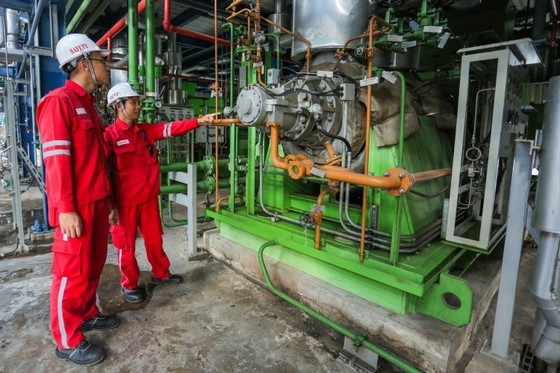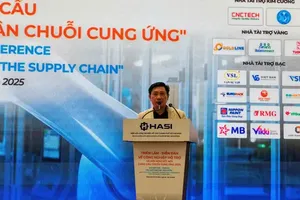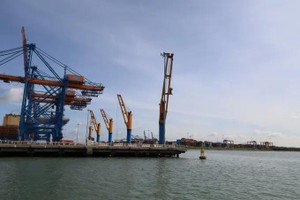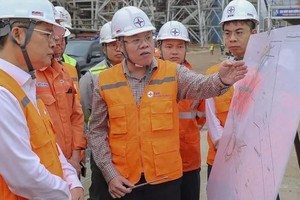 |
Nhon Trach 2 Gas-fired Power Plant (sited in Nhon Trach District of Dong Nai Province), operated by PV Power |
Tran Anh Khoa from the Unit of Sources and Market Development (under PetroVietnam Gas JSC. – PV Gas) informed that the domestic gas sources for energy production have seen remarkable reduction year after year. In 2023, the gas amount to harness electricity in the Southeast region is only 4.3 billion cubic meters per year. Predictions show that in 2030, the figures will drop to 1 billion and 0.6 billion in the Southeast and Southwest regions, respectively.
PV Gas commented that the import of LNG is unavoidable with the direction that Vietnam will no longer use coal to create electricity. The trade-in amount from abroad will both supply new LNG projects and compensate for the shortage in existing gas-fired power plants. General Director of PV Gas Pham Van Phong affirmed that this LNG importing is an important and irreversible energy trend in the global energy market to timely supplement any natural gas shortages due to decreases in domestic gas reserves.
In Vietnam, PV Gas is the only permitted organization to buy LNG from other countries. It launched its Thi Vai LNG Terminal in July 2023, with the capacity of its first and second stages at 1 million tonnes (in 2023) and 3 million (in 2026) a year, correspondingly.
In the South-Central Coast region, PV Gas is working with AES Corporation (the US) to construct Son My LNG Terminal, expected to run in 2026. The capacity of its first and second stages will be 3.6 million and 6 million tonnes per year.
In the North region, PV Gas is planning to invest in its Northern LNG Terminal for a capacity of 3 million tonnes a year in the first stage and 6 million in the second one. Obviously, PV Gas is the pioneer in building necessary infrastructure for LNG imports and supply to the domestic market.
Having said that, Dr. Nguyen Quoc Lap, Chairman of the Vietnam Petroleum Association (VINPA), still concerned about possible challenges in implementing LNG projects in the country. The first could be insufficient legal corridor for a suitable replacement when the Government guarantee is removed (via financial regulations and charters of state-owned economic organizations like EVN, PVN).
Adding to that is a lack of guarantee for currency exchange and international payment obligation when importing LNG. There is no consistent price frame for electricity harnessed from LNG, nor is there any commitment to the total yearly energy output or projects’ transmission and connection systems.
Dr. Lap proposed that urgent measures should be adopted: introducing suitable mechanisms so that an LNG power plant like EVN has power to negotiate directly with consumers to sell electricity, power plants are able to directly buy LNG and lease a space for storage as well as regasification, and finally power plants can invest in transmission and connection lines.
He stressed that LNG electricity prices should be negotiable in compliance with the principles of the market just like other countries in the world.
One more challenge to LNG importers is that to satisfy the needs of all 13 LNG energy projects in 2030, the capacity of domestic warehouses must reach 15 – 18 million tonnes of LNG per year. Sadly, the current capacity of Thi Vai LNG Terminal – first stage is only 1 million tonnes a year. Even when stage two comes into operation, there is still a serious lack.
Meanwhile, to fulfill the goals of net zero carbon dioxide emissions by 2050 as committed by the Government in the 2021 United Nations Climate Change Conference (COP26), all LNG power plants have to use hydrogen partially or totally for burning. This means LNG projects and terminals will only have about 20 years of operation before the power plant switches partial or total operation on hydrogen.
Counting certain tardiness, some projects might not have enough time to recover their capital. Hence, to minimize risks for businesses, experts suggested that there should be appropriate plans for domestic gas-fired and LNG power plants to turn to hydrogen use so as to ensure their profits.
Other experts mentioned the expected high price of electricity from LNG and its dependence on market fluctuations, not to mention huge investments in warehouses, regasification infrastructure, and gas transportation vehicles. It is, therefore, necessary to carefully calculate the total costs of electricity harnessed from LNG before deciding to pour investments in this sector.
Predicted risks and geopolitical fluctuations from now to 2030 are also factors to increase the prices of LNG imports, which is another concern of investors since this will obviously affect the performance of an LNG project as well as the retail electricity price in negotiations.
Finally, LNG importers proposed to concentrate on developing infrastructure for LNG power in certain centers and then delivering the gas to satellite thermal power centers. This is the optimal cost solution to reduce production expenses from imported LNG.
Deputy Director Bui Quoc Hung of the Department of Electricity and Renewable Energy (under the Ministry of Industry and Trade) commented that LNG power has various advantages like huge supply, stable operation, high performance (reaching over 62 percent), quick activation to compensate for immediate capacity shortage of the current system (in case renewable energy sources stop generating power), reduction of harmful gas emissions.
This type can even completely replace all coal-fired power plants in the future, helping the electricity industry go green more easily.
The possible challenges for this new energy type in Vietnam is the obligation to follow regular investment procedures, the lack of a corresponding operation project, the difficulties and time-consuming in choosing suitable experienced investors, the need to fully import LNG that leads to unstable prices, and the urge to develop a price mechanism to avoid unwanted impacts on retail prices when supply prices fluctuate.
























